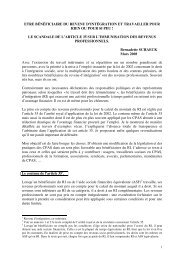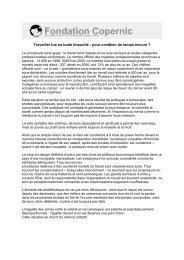Awra Amba RJ 300612 EN - Contacter un comité local d'Attac
Awra Amba RJ 300612 EN - Contacter un comité local d'Attac
Awra Amba RJ 300612 EN - Contacter un comité local d'Attac
You also want an ePaper? Increase the reach of your titles
YUMPU automatically turns print PDFs into web optimized ePapers that Google loves.
5. Education<br />
new library opened in August 2007 (see Picture 15). Yassin (2008/93) indicates a third library, of<br />
medium size. The 1997 library is built, as most of the houses are, with wood and mud, its benches<br />
and tables are made of stone, wood and mud, covered with plastic. There is no electricity in the<br />
library (in 2010), which is open from 5 p.m. till dusk. R<strong>un</strong> by a librarian, the books are referred to on<br />
site by the scholars and students of the village, and practically never by adults, who "have no time<br />
for reading", we were told. This absence of reading by adults contrasts with the impression given by<br />
Ya08/93 of wide access of comm<strong>un</strong>ity members to world cultures through the library, "manifestation<br />
of their love of wisdom".<br />
The library had in 2010 aro<strong>un</strong>d 500 books, of which more than 90 % concerned languages and<br />
natural sciences: there was hardly any literature, and practically no social sciences. Zumra considers<br />
that technology is the most important subject and gives a lot of importance to practice: culture, social<br />
and human problems are learnt in the comm<strong>un</strong>ity itself and especially from him, whereas technology<br />
can only come from the outside. This almost exclusive fascination for the hard sciences and<br />
technology seems to be quite <strong>un</strong>usual in Ethiopia (Jo10b/6).<br />
Picture 15: The new library in April 2010.<br />
Finally, the comm<strong>un</strong>ity has since 2012 a quite big room equipped with some chairs, so-called<br />
museum. On the walls there are some large sheets on which are written some principles of the<br />
fo<strong>un</strong>der and of <strong>Awra</strong> <strong>Amba</strong>. It is used as a meeting room (Crespo, 2012).<br />
5.2. Public school<br />
In Ethiopia, the primary education enrolment ratio is 84 % in 2007-2009 according to Unicef (2012),<br />
although education is not compulsory (Ya08/43).<br />
The public primary school where went <strong>Awra</strong> <strong>Amba</strong> children till 2009 was located at Maksegn, one<br />
of the villages of the kebele of which <strong>Awra</strong> <strong>Amba</strong> is part (Question 35 in Annex). 18 teachers,<br />
including 10 women, taught here aro<strong>un</strong>d 1600 students of whom 75-80 were from <strong>Awra</strong> <strong>Amba</strong><br />
(Yi07/72 & 86). Since September 2009, an eleven-classroom school (level 1 to 8) has been opened<br />
near the village (Picture 16). Since September 2011, two new classrooms opened, corresponding to<br />
level 9 to 10 (Crespo, 2012). It corresponds to a primary school (first cycle, level 1 to 4), a middle<br />
school (second cycle, level 5 to 8) according to Yi07/8, and a secondary school (level 9 to 11, this<br />
last level should open in September 2012).<br />
65 / 85

















